Banlung Travel Guide: Discover One Of Cambodia's Hidden Gems
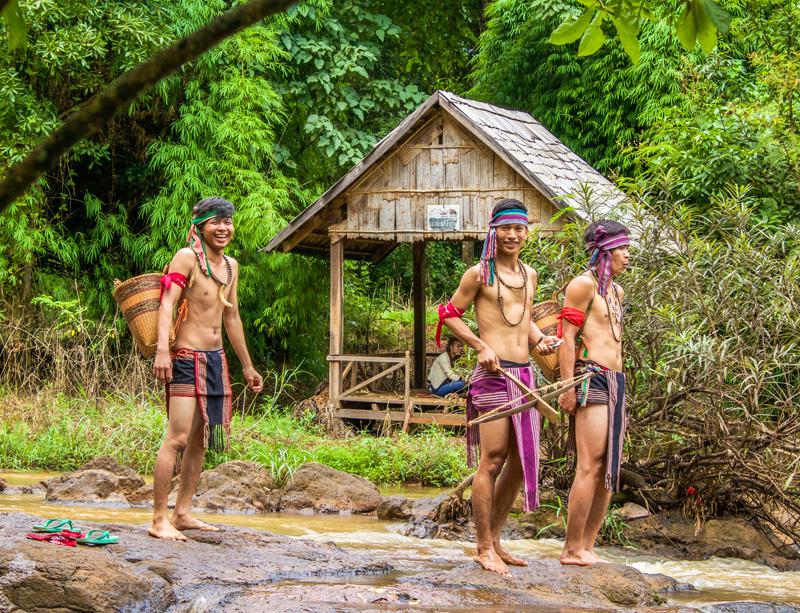
Many people who travel to Cambodia will only visit the better-known and more fashionable destinations like Siem Reap, Phnom Penh, Sihanoukville and Battambang.
This is a big mistake.
Sure, Angkor Wat is unmissable and a visit to the capital city of Phnom Penh to learn about the Cambodian genocide by the Khmer Rouge is an important part the Cambodia travel experience. But there is so much more.
We did visit a number of the most popular tourist attractions in Cambodia; Angkor Wat in Siem Reap, the Royal Palace in Phnom Penh, the Tuol Sleng Genocide Museum and so on.
But while we were impressed with these attractions, we were soon to discover that Cambodia also has a sizeable number of hidden gems that lie well off the beaten tourist trail.
The little dusty town of Ban Lung happened to be one of those little gems that we were fortunate enough to discover during our travels in Cambodia.
In this article, we’re going to show you 4 exciting things to do in and around Ban Lung, so that you can get more out of your Cambodia trip than the average tourist.
First though, let's get the basic information out of the way.
Ban Lung
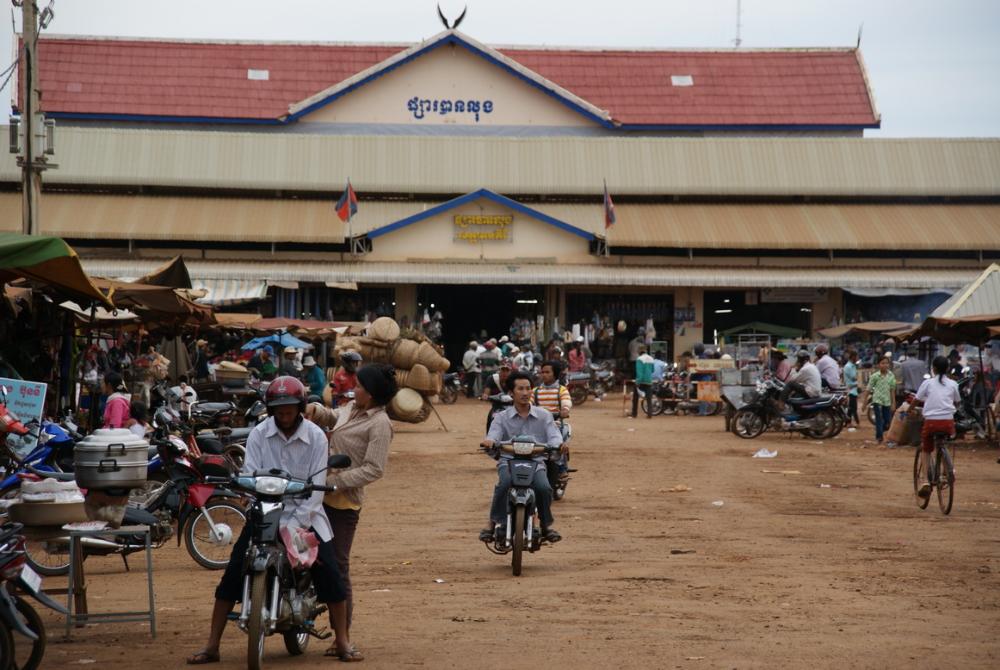
Ban Lung is a dusty little town in Ratanakiri Province, located about 636km from the capital city of Phnom Penh.
This region is Cambodia's wild northeast and is the most sparsely populated province in the country, with a total population of just 184,000. It's also one of the poorest provinces in the country with very low life expectancy and literacy rates.
The town of Ban Lung has the same name as the surrounding district (Ban Lung district) and is the provincial capital of Ratanakiri Province.
Ban Lung today has a population of about 17,000 and was established as the provincial capital in 1979. Prior to this, its name was Labansiek.
The town is known locally as ‘dey krahorm’, which means ‘red Earth’. You’ll understand where this name comes from when you arrive there; almost everything in the town is coated in the red dusty soil that characterizes the region.
Getting there
We reached Ban Lung via the 12:30 p.m bus from Kratie (cost $8), but it's also possible to reach the town directly from Phnom Penh, Stung Treng and Sen Monorom.
Minivans go to Ban Lung from all of these places, but larger buses are only available if you're coming from Phnom Penh or Kratie. If coming from Phnom Penh, the large bus will be significantly cheaper than the minivan, but slower. From Kratie the minivan and bus seem to be the same price however.
Private taxis from Phnom Penh can also take you to Ban Lung, but only if you're willing to fork out around $120.
For more information on getting to Ban Lung, see here.
Map of Ban Lung
Here is a map of Ban Lung to help you visualize the layout of this town and to help you find the locations that we’re going to describe in this article.
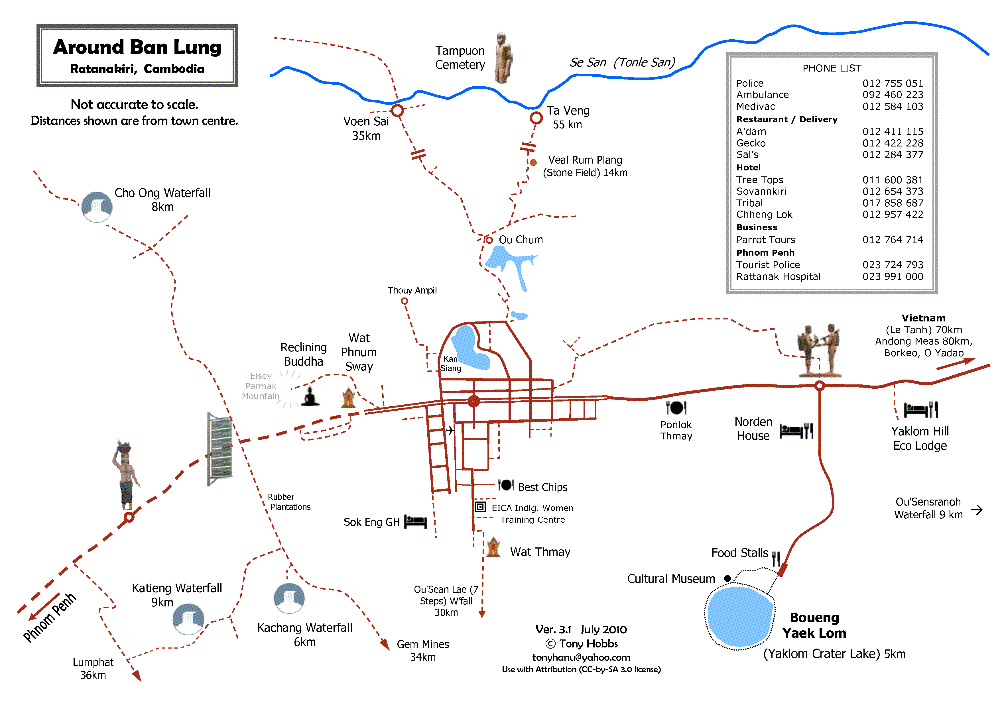
Where to stay
If you arrive in Ban Lung by bus like we did, you'll probably be dropped at the main bus terminal, which is about 3km southwest of the town centre.
Here you'll probably be greeted by a swarm of Tuk-Tuk drivers looking to make an easy commission by bringing you to a guesthouse that will pay them. This is not such a bad thing, especially if you're carrying heavy luggage and don't want to walk along the dusty roads in the Cambodian heat.
We just told the first Tuk-Tuk driver that spoke to us our very low budget and he was happy to drive us to a guesthouse called Sunset Village that fitted the bill perfectly.
This is a very laid-back resort, where you can stay in little wooden huts furnished with little more than a comfortable bed, ceiling fan and mosquito net. Every evening you can watch the sunset from your porch or from the attached restaurant. Pure bliss.
If you don't want to stay here, there are numerous other guesthouses and several hotels in Ban Lung, so don't worry about being able to find accommodation. Search for Ban Lung accommodation online here.
4 exciting things to do in and around Ban Lung
The main draw of Ban Lung is not the town itself, although the central market does offer some gustatory delights to foreign visitors.
Where the magic really exists though is in the environs; in the breathtaking scenic landscapes, spectacular waterfalls, charming Buddhist temples, sparkling crater lakes and the intriguing gem mining sites.
Without further ado, here are 4 awesome things to do in Ban Lung:
1. Try the delicious street food

When in Ban Lung, you should try some of the local street food. One of our favourite items were the grilled bananas near the central market. These are not so easily found outside Cambodia and Thailand, where they seem to be very popular.

These grilled bananas are really cheap too. You can get a small bag or a skewer of them for only 1,000 riel ($0.25). Did we forget to mention that they're delicious?
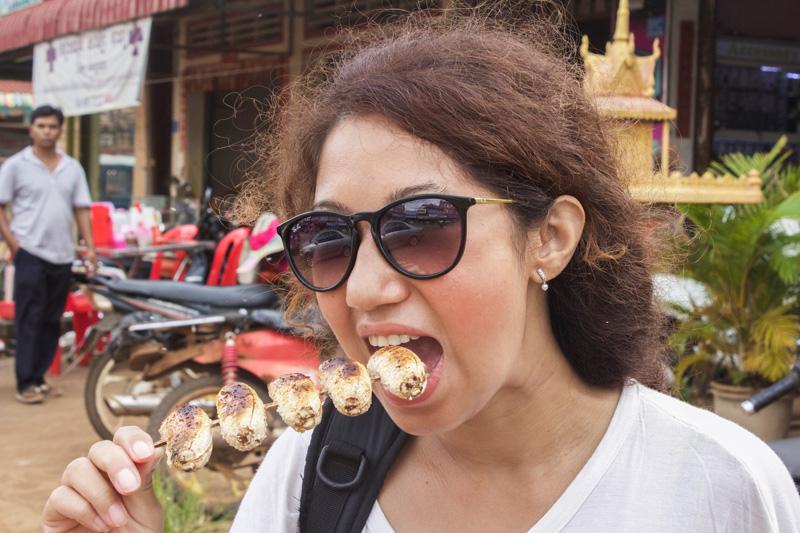
Meat-eaters might be tempted by the spit-roasting chickens or the smaller quails, which are normally only $1 each.

We also visited a restaurant in Ban Lung that is reputed to make some of the best coconut shakes in Southeast Asia. The restaurant is aptly named the coconut shake restaurant.
The restaurant is found at the northeast corner of the small lake that’s found North of Ban Lung’s central market area.
We can confirm that the restaurant’s reputation is well deserved, as they were indeed some pretty amazing coconut shakes. We found ourselves returning to the restaurant several times just to order the coconut shakes, which only cost $1.
While the restaurant does excel in making coconut shakes, it doesn’t excel in spelling English words. Take a good look at the menu here and you’ll spot some very amusing spelling mistakes.
2. Experience the amazing waterfalls
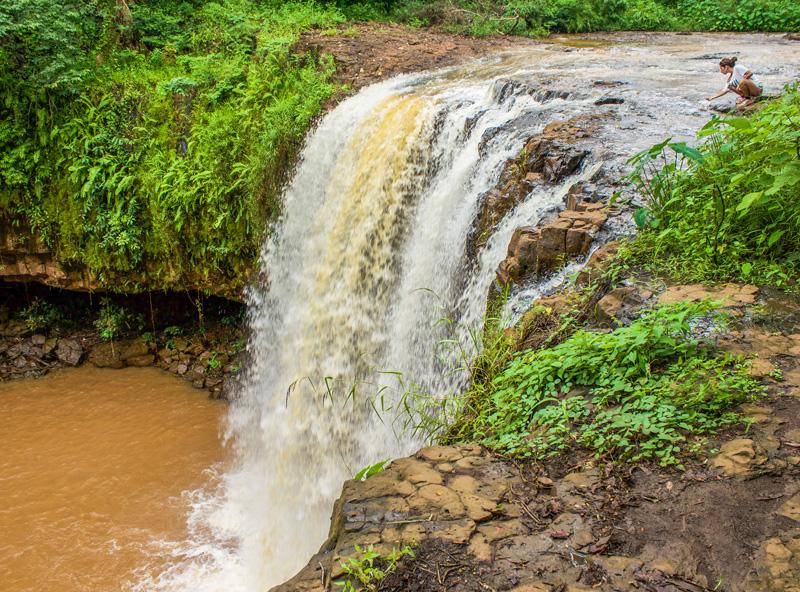
Perhaps our favourite thing about Ban Lung was the majestic waterfalls. There are three main waterfalls in easy reach of the village, namely Kachang waterfall, Katieng waterfall and Cha Ong waterfall.
The waterfalls are all several kilometres from the town and the most economical way to reach them is by bicycle or motorcycle. Personally, we visited all three waterfalls on locally hired bicycles and got some great exercise on the bumpy roads in the process.
Less independent travellers with plenty of money may be able to hire a motorcycle-driving local guide, a 4WD or perhaps even a tuk-tuk (although some of the roads to the waterfalls may be too bad for a tuk-tuk).
There are ticket booths next to all the waterfalls here, which, in theory at least, charge a small entrance fee for tourists, but the entrance fees weren’t being strictly enforced. To avoid them, it’s often enough to just shrug your shoulders and say you’re not carrying any money.
Kachang waterfall
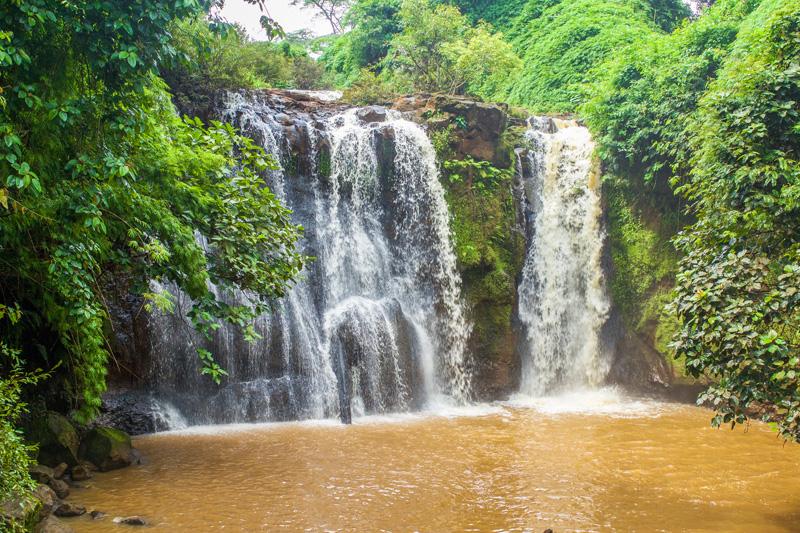
This waterfall is located about 7.5 km south of Ban Lung. The best way to get there is to head west out the main road for about 2.5 km, before taking a left turn down a long dusty and bumpy road that eventually brings you to the waterfall.
Once you arrive at the river, you must descend down some steep wooden steps to be able to view the waterfall. You can descend all the way down to the river beneath the waterfall, where it’s possible to bathe.
There’s also another route that brings you down to a wooden suspension bridge that spans the river gorge. You can walk across to the middle of the bridge for an excellent view of the waterfall.
.jpg)
The waterfall itself is about 10 metres high and surrounded by lush vegetation. It belongs to a small local river called the Kontung stream, which flows into the larger Sre Pok river.
At the upper level of the waterfall, we spotted some Cambodian boys dressed in tribal attire and carrying pack baskets and crossbows:
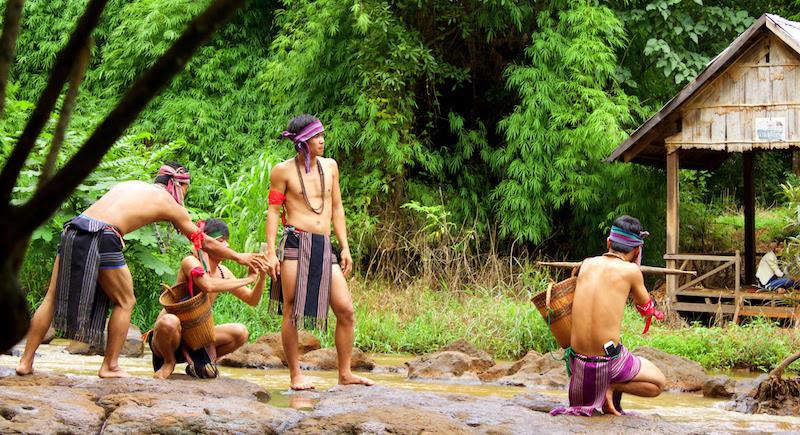
Katieng waterfall

This waterfall is about 4.5km further on from Kachang waterfall and in total is about 11km from Ban Lung.
It’s another waterfall on the exact same river, just further downstream. To get there, take the right turn about 200m before you reach the Kachang waterfall.
The Katieng waterfall is about 10 metres in height and located in a very beautiful and serene forest setting.
What you’ll love about it is that it’s possible to descend to the river below and clamber across the rocks and boulders that lie underneath the waterfall’s overhang. There are long vines and creepers dangling into the cave behind the waterfall from the cliffs above.
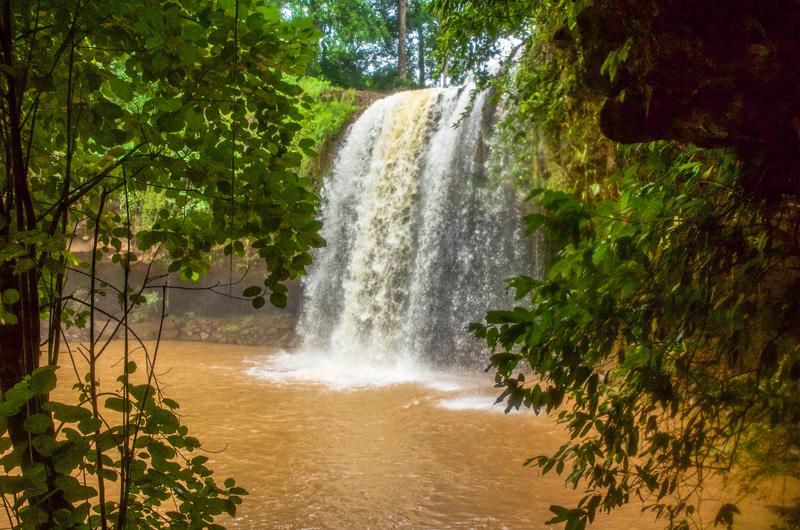
Just near the waterfall, we encountered a small souvenir shop, selling some interesting wood carvings and other trinkets like gongs and buffalo skulls. Nobody was around though.
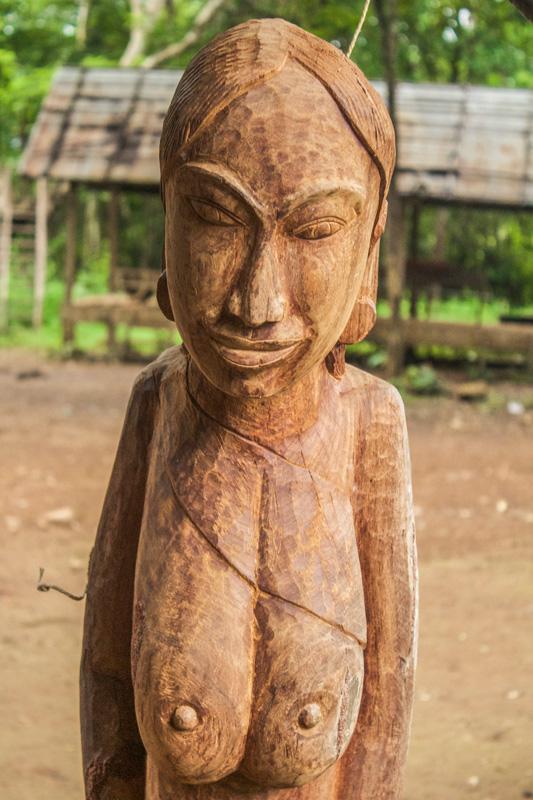
.jpg)
Just a few hundred metres from the souvenir shop, in a little grassy field, we spotted a gang of turkeys, mostly female ones (hens). There was this one beautiful male turkey though:

Male turkeys (gobblers) typically put on displays like this to attract female turkeys for mating. Note how he's puffing out his feathers and fanning his tail. Turkeys will also drag their wings along the ground as part of the display.
Cha Ong waterfall

The Cha Ong waterfall is about 8.7km from Ban Lung, near Cha Ong village. It’s the most visited of the waterfalls around Ban Lung and probably our favourite of the lot.
Directions: To get to Cha Ong waterfall, head west on the main road out of town and take the right turn a few hundred metres after the bus station. Go along this road for about 6km until you reach the waterfall.
Sometimes the journey to a place is just as delightful as the destination itself and with the Cha Ong waterfall, this is certainly the case. We were captivated by the beautiful undulating landscapes that we witnessed on the way out to this waterfall.
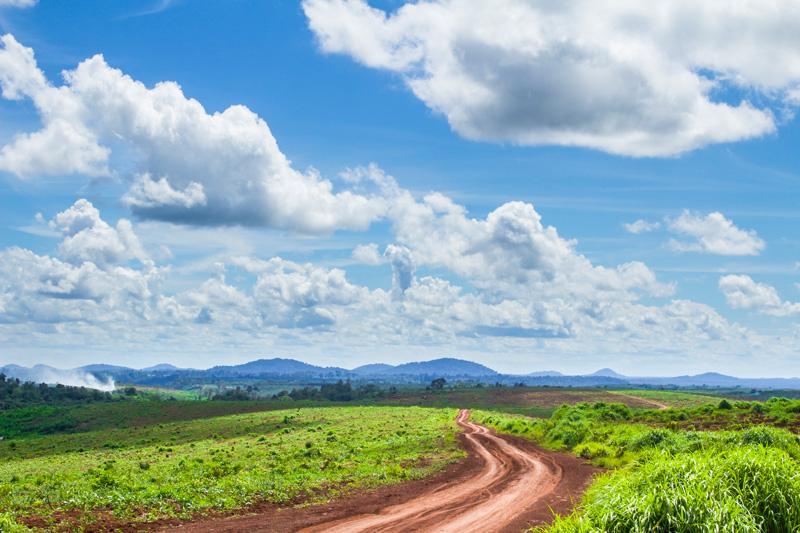
Rattanakiri province came under French colonial rule around 1893 and the French used the indigenous workers for the construction and tapping of huge rubber plantations around Ban Lung. They are still in use today and we passed by several of these on our way to the waterfall.
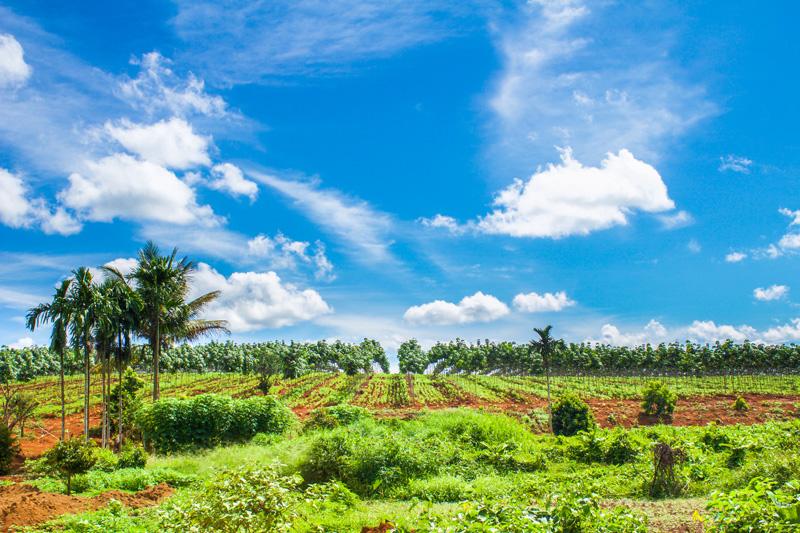

The waterfall itself is not a let down either. Named by the local Kreung hill tribe, Cha Ong waterfall is a plunging cascade that falls over 18 metres to the rocks below.
It’s not normally as wide as Kachang or Katieng waterfall but it’s certainly a lot taller than both of them.
When you reach the waterfall after descending down a slope, you can walk into the space behind the waterfall and observe the green forest through a curtain of fine mist and falling water.
Previous visitors have unfortunately disgraced the natural beauty of waterfall by writing graffiti on the rocks behind it.
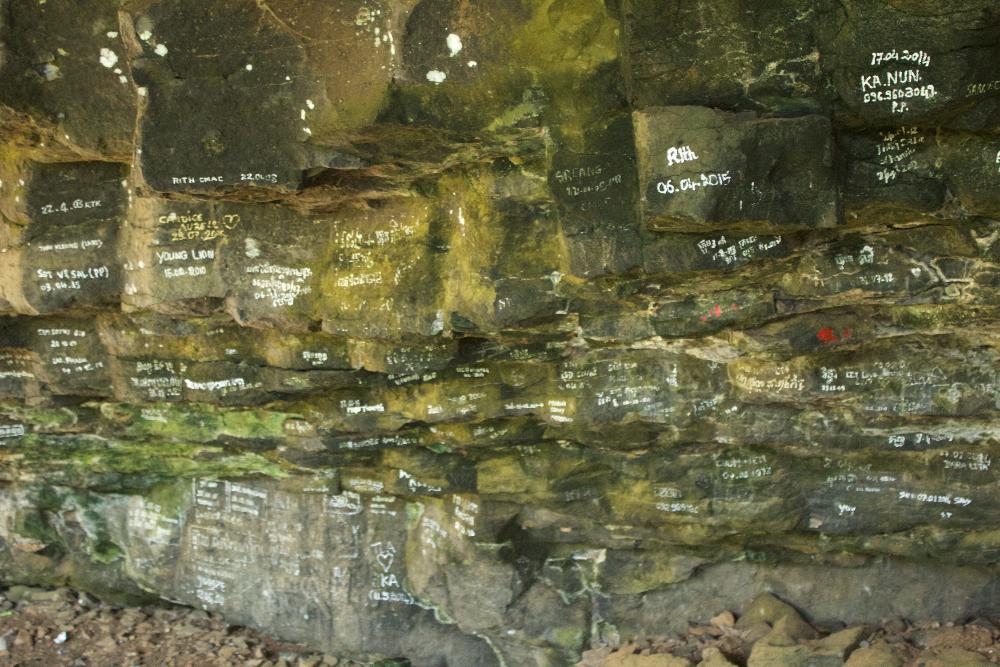
It’s also possible to wade in the river at the top of the waterfall and (if you dare) peer over the edge.
.jpg)
The whole area here around the waterfall has a very wild ‘lost in the jungle’ kind of feel. Don’t forget to explore the surrounding area a little for wildlife. You might find beautiful surprises like this great mormon butterfly:

Great mormons are butterflies that belong to the swallowtail family and the females appear in several different morphs or forms. Many of the forms are designed to mimic unpalatable butterflies so that the females don't get eaten.
If you've visited all three of these watefalls and you're still hungry for more, there are two more waterfalls we suggest you visit, but you will have to travel further for them. We didn't visit these two ourselves by the way.
Ou' Sinlair waterfall is a waterfall with several tiers, located about 16km south of Ban Lung. Ou' Sensranoh (Ou Senmonorom) waterfall is allegedly 9km south of Ban Lung and 18m high, although we couldn't find it on google maps.
3. Check out Boeng Yeak Lom crater lake
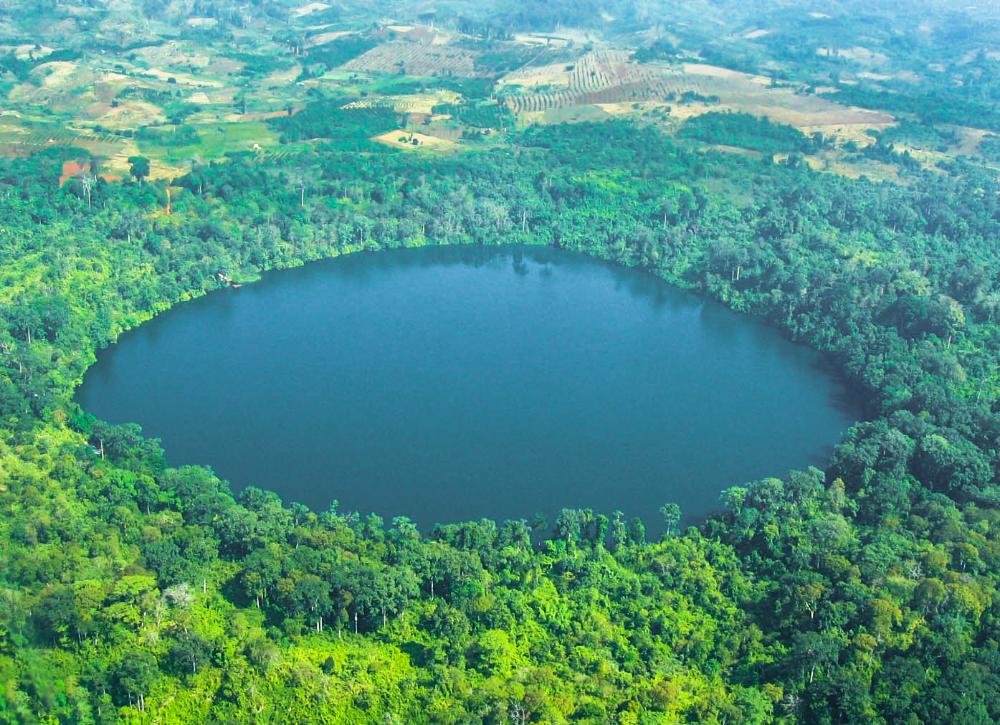
Boeng Yeak Lom is an almost perfectly circular lake, located about 5km from Ban Lung.
The emerald-hued lake is about 0.72 km in diameter and is ringed by dense forest that is full of exotic birds and parrots. Some believe the lake occupies a 4,000 year-old volcanic crater, while others think the crater is over 700,000 years old and was formed by a falling meteorite.
As you might guess, the lake is tremendously deep (48m) and this is a positive thing as it helps to keep the water clean and clear.
The lake is a sacred place to the indigenous minorities and they believe that mysterious creatures inhabit the waters, but don’t let that deter you from swimming. We came out alive after a good long swim in the lake after all.
Directions to the lake: To get there, head east out the main road from Ban Lung and take the right turn after about 3.5km. Take another right turn off this road after about 1 km and you’ll end up at the lake.
What to see and do at the lake
When you arrive at the lake, the first major points of interest (other than the lake itself) are the bride and groom stilt huts of the Kreung minority people, just near the main entrance.
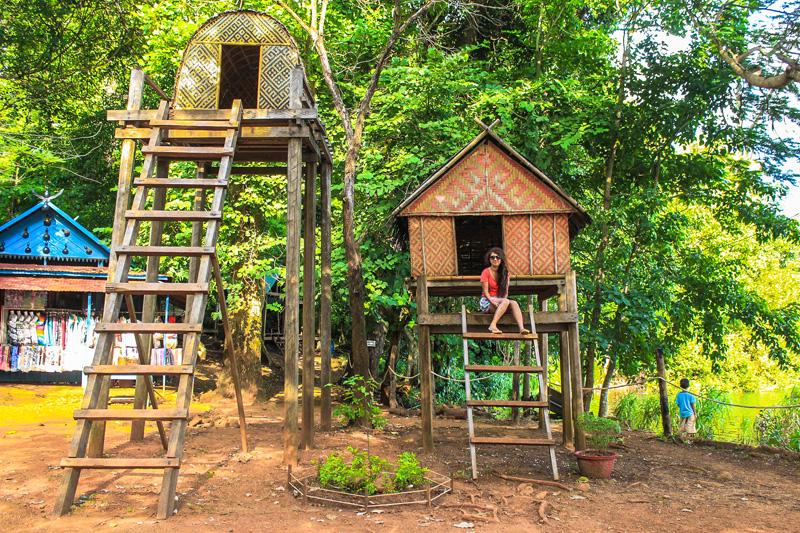
These two huts here near the lake are not actually in use but rather just on display for tourists. But what are they?
Basically, once they reach a certain age, many Kreung teenagers (both boys and girls) traditionally move out of their parents’ homes and into these huts. The boys usually build the hut themselves while the girls might have their parents organize one to be built for them. In moving out into these huts, the teenagers have a chance to gain independence in living by themselves.
Not only that, but the huts give them much needed privacy from their parents and an opportunity to meet members of the opposite sex on their own terms.
Teenage boys and girls use the huts to invite members of the opposite sex to spend time with them inside the huts and if they like each other, they might sleep together. Teenagers that fall in love are then encouraged by the parents to cohabit together in one of the huts before marriage.
The boys tend to build their huts taller than the girls. Hence the taller hut on the left of the photo is an example of a groom hut and the smaller one on the right is a bride hut. The huts have also been called ‘love huts’, since they give young couples the space and the opportunity to fall in love.
Unfortunately the Kreung people rarely use the love huts nowadays and they’re normally just left standing for tourists to see. Their culture and traditions are being steadily eroded by the dominant Khmer culture in Cambodia.
Anyhow, getting back to the lake.
There are several wooden jetties around the edge of the lake that act as popular swimming areas, so you can stop off for a swim or two during the walk. It’s even possible to hire lifejackets here for extra buoyancy if you’re not a confident swimmer in such deep water. You'll have to pay a small fee for one though.
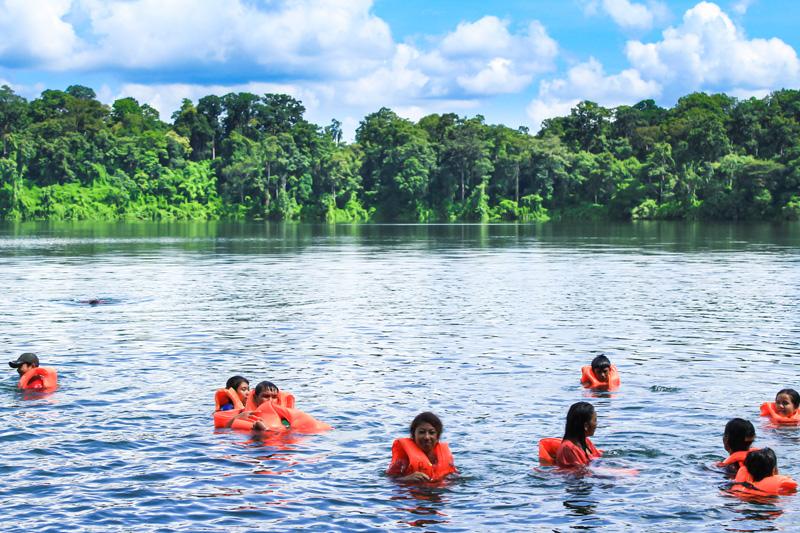
The local boys like to jump into the lake from high tree branches that overhang the water. We decided to join in and took a few plunges into the lake from an 8 metre-high branch.
The most daunting part was climbing the actual tree with slippery wet feet and then balancing out along a thin branch at the top of the tree, going right out over the water with nothing to hold onto with the hands. Crazy stuff! It was excellent fun though.
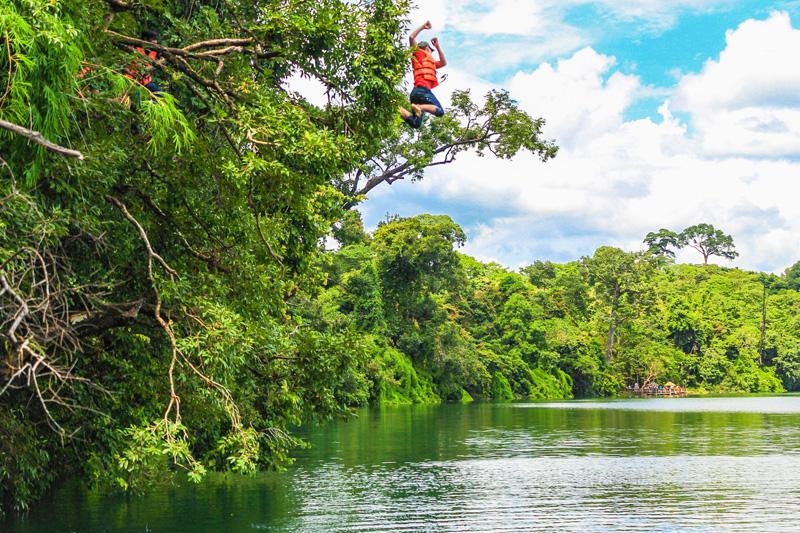
There’s also a small ethnic and cultural centre on the northwestern side of the lake, with a small exhibit on ethnic minorities. There are some displays inside here on tribal folklore and superstitions and a few tribal handicrafts but the place probably won’t hold your attention for long.
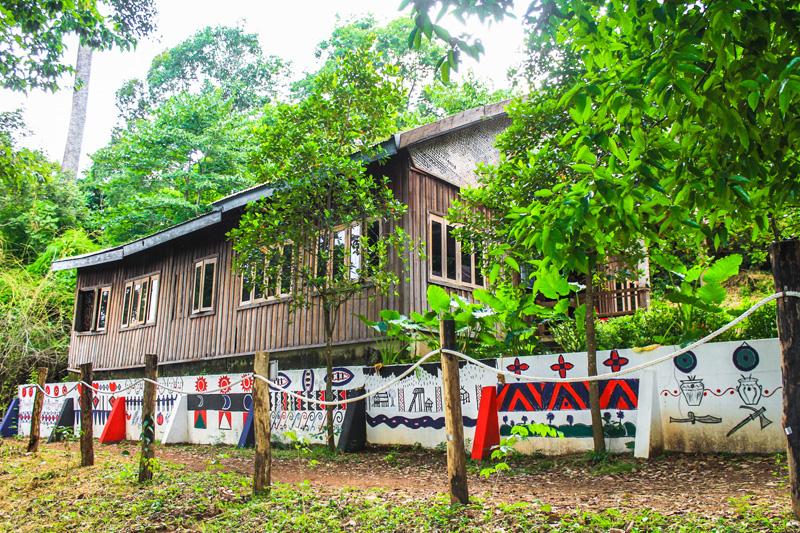
Apart from swimming and visiting the cultural museum, the best thing to do here is to make a complete circuit of the lake on foot. The path that rims the lake weaves it’s way through the lush jungle and is really quite magical.
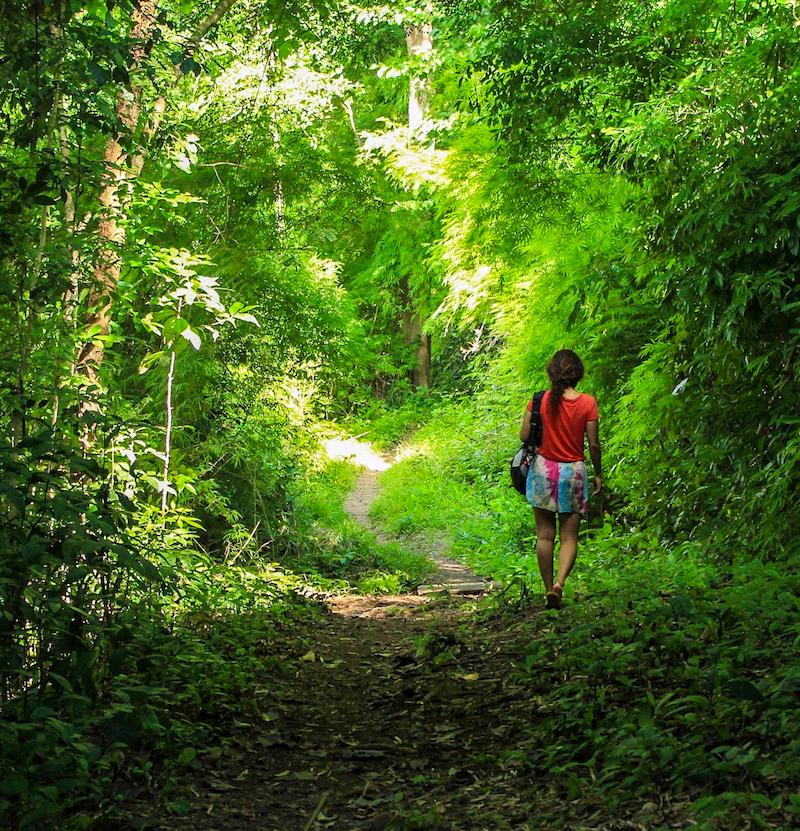
You may be lucky enough to spot a beautiful parrot or other tropical birds if you’re quiet enough during the walk. We spotted two beautiful butterflies on the forest floor.
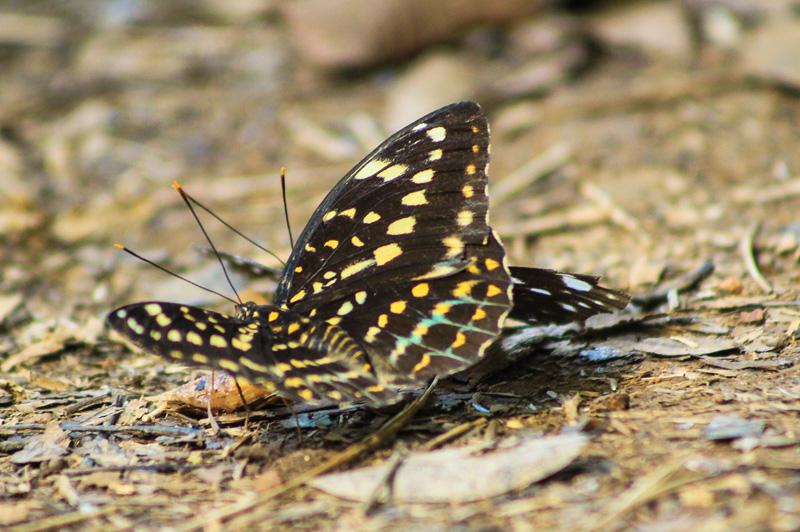
This is a pair of common archduke butterflies (Lexias pardalis). It’s a highly sought after species in butterfly farming due to its aesthetic value.
A very rare half-male, half-female version of this species was recently discovered by scientists at Drexel University in Philadelphia. It has the female markings on one half and the male markings on the other.
The forest also revealed a very beautiful fungus to us. The species we found is from the genus Coltricia and the different species in the genus are variously known by names like 'cinnamon polypore' and 'tiger's eye fungus'. The coloured concentric bands are exquisite and aesthetically pleasing:
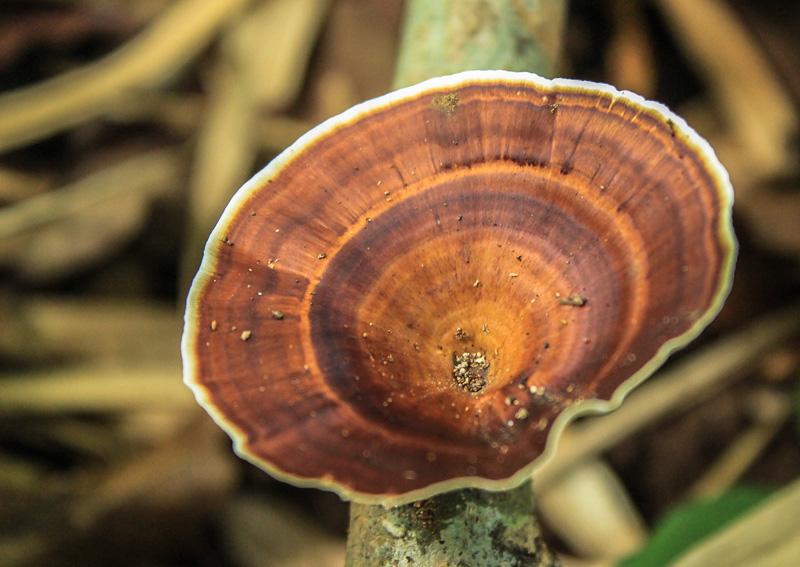
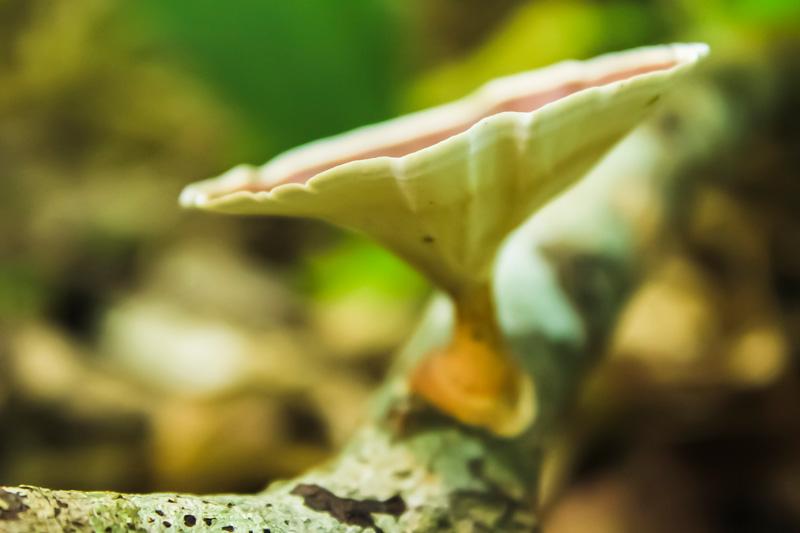
We also saw the beautiful flowers of a plant called ‘jungle flame’ or ‘jungle geranium’. Its botanical name is Ixora coccinea and the plant is used in Indian Ayurvedic medicine to treat various ailments:
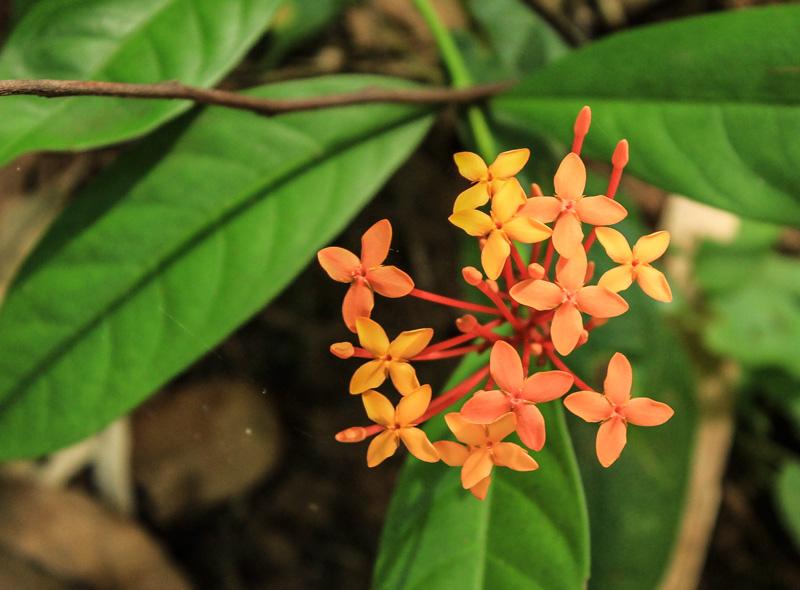
As you wander around the lake’s perimeter, there will be occasional glimpses of the lake through clearings in the vegetation:
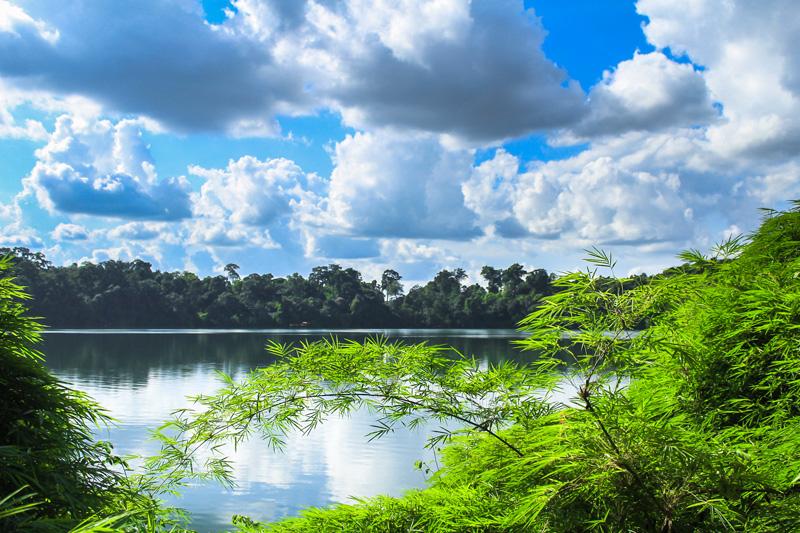
The circuit around the lake will eventually return you back to the starting point, where all the souvenir and refreshment stalls are found.
There are various decorative features installed at the lakes edge here for taking photographs. Try to make it back for the sunset. The light here is pretty amazing during the golden hour.

4. Visit one of the gem mines

The very name ‘Rattanakiri’ can be loosely translated to ‘gem mountain’. The province is rich in gemstones; brown zircon is the most abundant stone but amethyst, onyx and peridot are also found in smaller quantities.
To exploit this resource, there are several gem-mining sites found throughout the province but finding them is not easy. The mines are often hidden away, deep inside large rubber plantations and they’re also nomadic, shifting from one location to the next on a frequent basis.
Getting to the mines:
Because of the difficulty in locating the mines, you’ll probably have to hire a local guide to take you there. A boy at our guesthouse in Ban Lung knew roughly where one of the mines was located and he agreed to take us on his motorcycle for about $12.
It was quite a long journey heading out east and we went completely off-road onto some muddy, slippery dirt trails and into several plantation areas.
The boy was at first a little confused and unable to locate the mines but he talked to a few local people and eventually we found the mining site, in the midst of a huge rubber plantation.
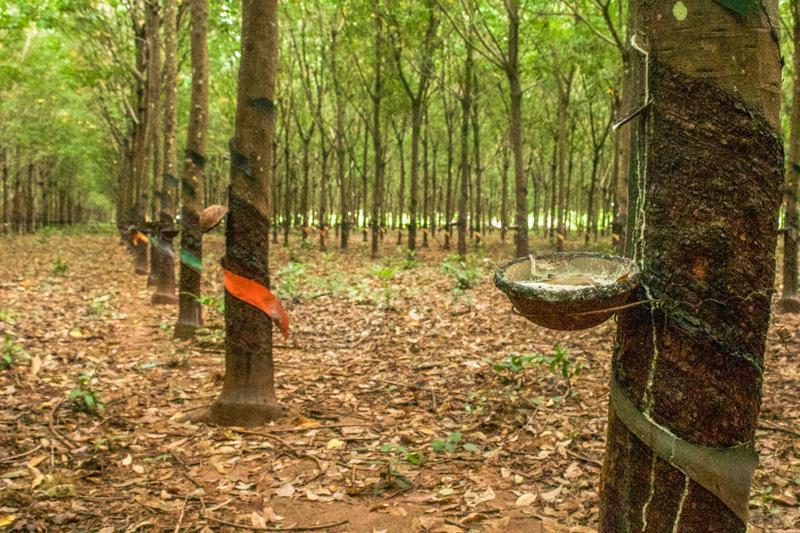
The gem mines
The mines are operated by groups of ‘precious stone workers known as kamakor tbong. The workers set up little temporary huts and encampments near the mines, since this is a highly nomadic occupation.
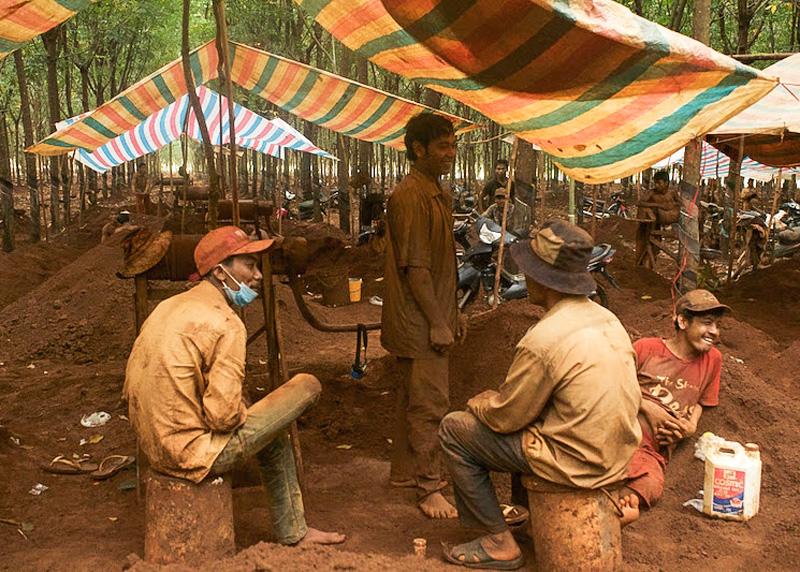
The miners have to manually dig out deep vertical shafts using handheld shovels and iron rods. The shafts are only 2 feet in diameter and can reach depths of 30-40 feet. The miners can dig out a shaft like this in a day or two.
Once a mineral vein is discovered, the miners then dig horizontally, filling plastic buckets up with loose Earth and pebbles and sending them back up to the top. The miners have amazing stamina and can stay underground in the claustrophobic mine shafts for up to 4 hours at a time, armed with nothing but a dim headlamp.
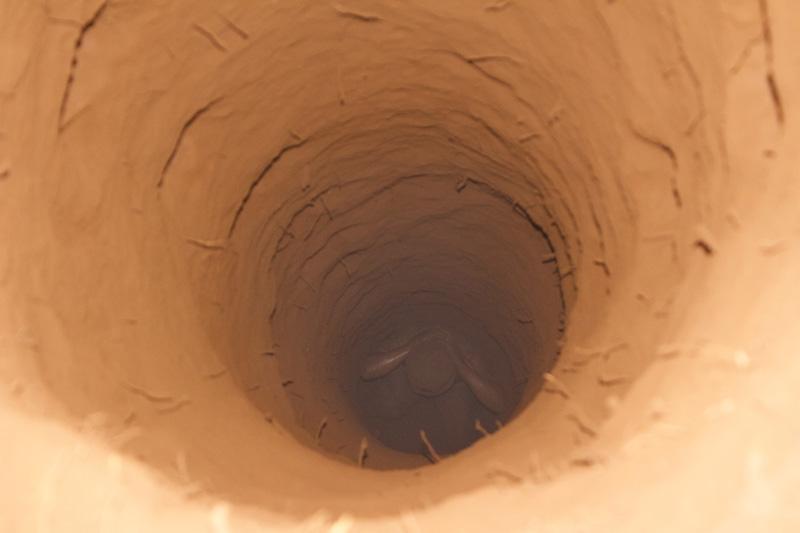
The filled buckets are winched up the shaft by a second miner, using a simple wooden pulley known as a ‘rovey’.
Once the bucket reaches the top, the material is emptied out and meticulously sifted through for gemstones. Water is not used to sieve the stones because it’s not always available and logistically impractical.

If a gemstone is found (and one may not be found for several days) the finder must sell it to the wealthy landlord who owns the site. It’s all heavily supervised. The miners also don’t know how to distinguish value in a gemstone and they are inevitably paid for very little for their finds, earning between $100 and $200 per month.
The stone will then be passed on to a gem broker in Ban Lung and if it’s a zircon, it’ll be given a heat treatment to produce the brilliant blue zircon gemstone that Rattanakiri Province is famous for.
The cut and polished stones are fitted into rings, earrings, necklaces and other jewellery items and then sold for hundreds or even thousands of dollars in Cambodia and overseas.
We saw plenty of blue zircon and other stones for sale in specialty gem shops in Ban Lung as well as in the local gem market.

.jpg)
The sad reality of the mining industry in Cambodia is that many of the workers here don’t really have a choice.
These people were traditionally able to sustain themselves by farming and small-scale hunting, gathering and fishing but land grabbing has become a common problem in the province, with tracts of old-growth forest being sold off to investors by the Cambodian Government and used for planting cash crops like cashew and rubber. Timber logging is another thing that’s destroying the region’s forests.
The traditional rice harvesting work cannot sustain these people as it’s only a seasonal affair and it pays poorly. Besides, many of them have been evicted from their lands and have nowhere to plant rice. The indigenous people of the region have thus become trapped in poverty and are forced to work in the mines to support themselves and their families.
Fatal accidents at the mines are not uncommon and each year, collapsing mineshafts kill between 3 and 5 workers. Miners will also occasionally loose their footing and fall down the shafts to their death, thrusting the families further into poverty.
Child labour is another sad aspect of the mines. Children between the ages of 5 and 12 are often forced to work at the mines in order to help support their poverty-stricken families. We saw children at the mines we visited but we didn’t witness any of them working.
If you visit the mines, you may be able to buy gemstones directly from the workers. They can earn better money this way than by selling the gems to the landlord.
When we visited, several women kept pestering us to buy gemstones. In fact, it was difficult to just walk around and take a good look at the mining site without them nagging us.
In the end, we succumbed and bought a small lump of brown zircon from one of the women. With much haggling and negotiation, we ended up paying around $6 for it.
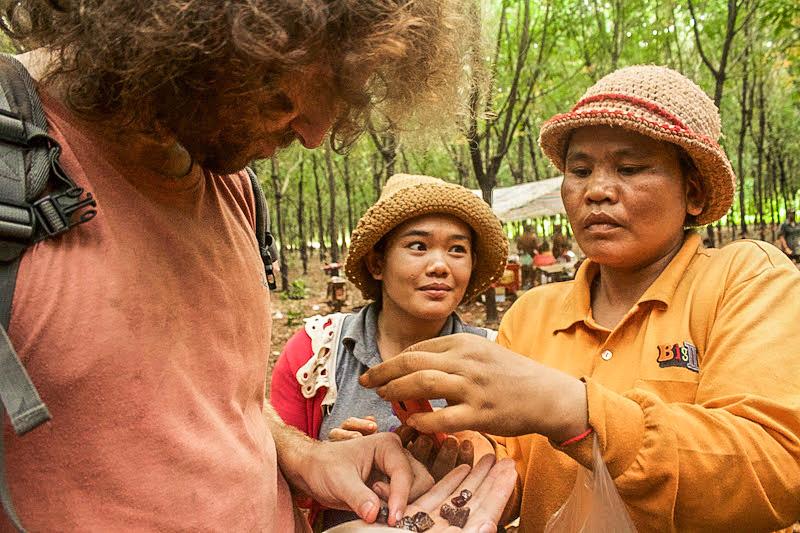
Other things to do around Ban Lung
If you’re wondering what else there is to do here apart from what we’ve already mentioned, we suggest you check out the Eisan Ratanaram pagoda just east of the town and the large reclining Buddha on the hilltop above the pagoda.
Ban Lung is also a popular place for trekking. It’s possible here to organize guided treks to several minority ethnic villages and scenic areas.
Another possibility is trekking in the Virachay National Park, one of the wildest and most remote parts of Cambodia.
Do be warned however that some of the treks don’t penetrate deeply into the park and spend much of the time in the park’s buffer zone.
Budget travellers will realistically need to form a group to make the treks affordable since prices can vary between $15 and $30 per day.
Recommended Guidebook: Lonely Planet Cambodia
If you enjoyed this travel guide, please share it and leave us a comment below. What's your favourite off-beat travel destination in Cambodia? We'd love to hear your feedback.
Your content goes here...
JOIN OUR LIST
SUPPORT US
FOLLOW US
ABOUT US
Our names are Eoghan and Jili and we hail from Ireland and India respectively.
We are two ardent shoestring budget adventure travellers and have been travelling throughout Asia continuously for the past few years.
Having accrued such a wealth of stories and knowledge from our extraordinary and transformative journey, our mission is now to share everything we've experienced and all of the lessons we've learned with our readers.
Do make sure to subscribe above in order to receive our free e-mail updates and exclusive travel tips & hints. If you would like to learn more about our story, philosophy and mission, please visit our about page.
Never stop travelling!
FOLLOW US ON FACEBOOK
FOLLOW US ON PINTEREST
-lw-scaled.png.png)


